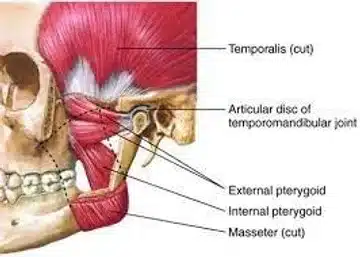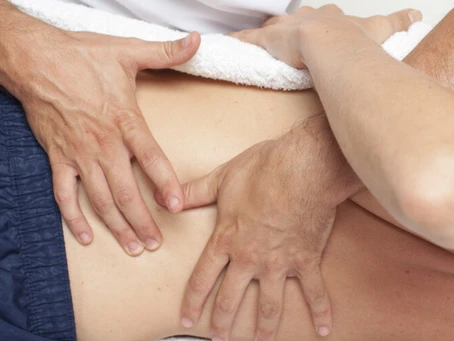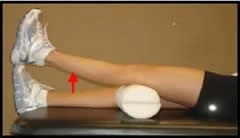You may have heard of a TMJ injury in the past; however, you may not know exactly what that means. TMJ stands for temporo-mandibular joint, or the jaw joint. It is where your skull meets with your mandible, or lower jaw (see picture below). It is located almost right beside the ear canal.
In the zoomed in portion of the picture, you can see something called a “disk”. This makes the TMJ a complex joint due to the way the bones and the disk move together.
There are several different disorders that can develop in the TMJ region, and due to the joint’s complexity and its proximity to the neck, the pain associated with these disorders can present in many different ways. In the following article, I will outline what myofascial, or muscular, dysfunction of the TMJ looks like.
The first, and one of the more common disorders that can develop, is essentially muscular pain. There are many muscles around the region that can get sore and irritated, leading to several different patterns of pain. In the following picture, you can see there are 3 main muscles, the masseter, temporalis, and pterygoid muscles.

The pterygoid is split into 2 parts, medial and lateral (or internal and external above). What’s important about this is that all these muscles EXCEPT for the lateral pterygoid are closers (or clenchers) of the jaw. And as we all know, when we get stressed, we tend to clench our jaw! If this happens, we can get many different types of pains.
First, headaches are VERY common with TMJ muscular disorders. As you can see with the temporalis muscle above, it runs right into the side of the head, almost to the upper part of the skull. If this muscle is sore, it can create one sided or both sided headaches. These can even radiate into the back of the head as well. In fact 50% of neck tension headaches also have a TMJ muscle contribution! Do you have that neck headache that never seems to go away no matter how much massage is done on your neck? Maybe your TMJ is the culprit!
Second, muscular dysfunction of the TMJ can lead to painful chewing and difficulty opening your mouth all the way. If you always struggle at the dentist to keep your jaw open for prolonged periods, you may have added tension in the muscles of your TMJ. This can then be sore for days or weeks after going to the dentist! This can be helped with the right treatment to the TMJ muscles, as well as the right exercises.
Lastly, tension in the TMJ muscles can both cause, and be caused by, something called “bruxism”. Bruxism is the unconscious clenching or grinding of your teeth, either at night or throughout the day. This can lead to several dental problems including, but not limited to, wearing down of the teeth, or misalignment of the teeth. Although bruxism can be unconscious, there are exercises and tricks that can be performed to help relieve the tension in your TMJ muscles to help reduce the negative side-effects of bruxism.
So now that we know a bit about what TMJ muscles do, and how they can influence a variety of different pains, how do we fix it?? Fortunately, there are some good physiotherapy and chiropractic techniques to help reduce muscle tension and alleviate symptoms. There are also some basic “dos and don’ts” to help you avoid aggravation of your TMJ.
First off, I’m going to outline some of the things you should try to avoid to help reduce muscle tension in the jaw. First, and arguably most important, avoid prolonged slouching and forward head positions (ie. looking down at phones, or squinting to look at your computer screen). This causes a tensioning of the muscles in the front of the neck that pull the jaw open, therefore making us use our closing muscles more intensely to just keep our mouth shut. Second, especially if this is very painful, avoid chewing heavy meats, raw carrots, hard foods such as some nuts, and avoid taking big bites on burgers, apples etc. This can be painful and cause increased inflammation and irritation. You should also avoid chewing on gum, pen lids, lips, necklaces etc. Notice some of these habits where you are chewing on things and try to avoid as much as possible. One big habit that is hard for some people to break is nail biting. However as above, increased chewing and twisting of the jaw will increase tension in the closing muscles and cause increased pain. Another unneeded habit is resting your chin on your hand while at your desk or sitting on the couch. This causes a compression on the joint and tends to increase clenching of the jaw muscles. Lastly, and most simple, consciously avoid clenching your teeth! If you notice yourself clenching, just actively think about unclenching and loosening your jaw muscles.
There are many things you can do as well to help reduce muscle tension in the jaw. First, sit up tall, keeping your chin gently tucked in, especially when eating! This will help reduce the tension in the jaw needed to chew foods. When not eating, try resting your tongue on the roof of the mouth. This activates a muscle in the tongue that helps reduce the need for activation of the TMJ muscles, allowing them to loosen. The resting position for the muscles and joint of the TMJ is with your lips lightly touching, tongue on the roof of your mouth, and teeth apart and NOT touching. Try saying the name “EMMA” and then lightly pressing your lips together and this should be the resting position for the jaw muscles and joint.
There is also one simple exercise you can perform to help reduce your pain. However, this exercise is not always suitable for all TMJ dysfunctions, so if you have any problems with it, STOP and seek help from a therapist trained in TMJ disorders. To do the exercise follow these steps:

- Keep upright posture by imagining a string pulling up from the top and back of the head towards the ceiling.
- Keep tongue at the roof of the mouth
- slowly open your mouth by focusing on bringing the chin towards the throat (slightly backwards while opening), keeping your tongue on the roof of your mouth still.
- Hold end position for 5 seconds, then slowly release. Repeat this movement about 5x, and you can do this exercise 5-10x/day even! I like to do it when I’m stopped at a stop light or sitting watching TV!
For more information or to book your assessment contact us at 905-240-WELL (9355) or email us at claringtonphysio @gmail.com. Visit our website at www.claringtonphysio.ca.






